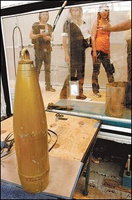 Detonation of hazardous munitions will take place in two-story, 110-ton setup
Detonation of hazardous munitions will take place in two-story, 110-ton setup
By William Cole
SCHOFIELD BARRACKS — Over the next three weeks, the Army will destroy 71 old chemical weapons here — the largest concentration of unexploded, or "dud" chemical rounds ever found in the United States.
"I don’t have an explanation yet in terms of why we saw 71 here and lesser quantities at (other locations)," said Tad Davis, deputy assistant secretary of the Army for the environment, safety and occupational health.
Army officials said an explanation for the high number of chemical weapon malfunctions may have been lost over time.
The phosgene and chloropicrin rounds, manufactured from World War I on, were stockpiled through World War II, the Army said.
The Army discovered the unexploded liquid-filled rounds from 2004 to 2006 during ordnance cleanup of an old range for a Stryker brigade "battle area complex." (continued…)
The chemical weapons, which include several-foot-tall 155 mm artillery shells, will be destroyed one at a time beginning today in a Transportable Detonation Chamber as part of a $7 million cleanup effort.
The media yesterday were given a tour of the 110-ton setup, which is being used for the first time in the United States for chemical weapons destruction after being tested in the United Kingdom.
A smaller device has been used to destroy smaller quantities of old chemical rounds found at firing ranges in the U.S., but it takes longer to process munitions, officials said.
"(The Transportable Detonation Chamber) provides us the capability to do 10, 20, 30 items a day," said Dale A. Ormond, deputy assistant secretary of the Army for the elimination of chemical weapons. "So this is the first opportunity where we found enough munitions where this process becomes economically feasible."
The chamber is a two-story-tall serpentine path of armored boxes, ducts, heaters, drums and sensors contained within a large tentlike structure in which the air is changed four times per hour.
The Army, which is leasing the chamber from company CH2M Hill, transported the setup by barge from the Mainland.
The chemical rounds will be destroyed one by one with up to 15 pounds of explosives in a freight elevator-size chamber with 1 inch of armor plating backed by 10 inches of sand and then more steel plate.
"Safety is our A-No. 1 goal," said David Hoffman, the Transportable Detonation Chamber program manager.
The fireball created by the explosion, with some steam added, destroys the chemical agent, and a series of over-pressure tanks treat and contain the exhaust.
The operation will take place at a remote "firing point" backing up to the Wai’anae Range at Schofield.
The rounds with chloropicrin and phosgene — both choking agents — were part of a haul of 250 "liquid-fill" unexploded munitions unearthed by the Army.
Most were determined not to be chemical weapons. Seven chemical rounds were deemed too dangerous to handle and were destroyed in place.
Of the 71 rounds to be destroyed, 70 have phosgene and one contains chloropicrin, the Army said.
Two other rounds with an unknown "liquid fill" remain on the firing range because an environmental lawsuit and court order halted unexploded ordnance cleanup, officials said.
The chemical weapons effort is one of several ordnance cleanups the U.S. government is working on in Hawai’i, whose strategic forward position in the Pacific has resulted in more than a century of military buildup.
A report on the health risks of both the chemical weapons and discovery of depleted uranium on O’ahu and the Big Island from a 1960s weapon system will be released in coming months.
Davis, the deputy assistant secretary of the Army, will meet tomorrow with Wai’anae Coast officials at 7 p.m. at Wai’anae District Park to discuss ordnance dumped in near-shore waters more than 60 years ago.
A $1.1 million study is expected to look at shellfish and limu health in the area, officials said.
A second study, expected to cost about $3 million, will include a "demonstration project" examining the advantages and disadvantages of removing old ordnance, some of which has become part of coral growth.
Go to original article
"Go to Original" links are provided as a convenience to our readers and allow for verification of authenticity. However, as originating pages are often updated by their originating host sites, the versions posted on VT may not match the versions our readers view when clicking the "Go to Original" links.
The opinions expressed on VT are those of the authors and do not necessarily reflect those of the staff as a whole.
(In accordance with Title 17 U.S.C. Section 107, this material is distributed without profit to those who have expressed a prior interest in receiving the included information for research and educational purposes. VT has no affiliation whatsoever with the originator of this article nor is VT endorsed or sponsored by the originator. Any opinions expressed by the author(s) are not necessarily those of VT or representative of any staff member at VT.)
ATTENTION READERS
We See The World From All Sides and Want YOU To Be Fully InformedIn fact, intentional disinformation is a disgraceful scourge in media today. So to assuage any possible errant incorrect information posted herein, we strongly encourage you to seek corroboration from other non-VT sources before forming an educated opinion.
About VT - Policies & Disclosures - Comment Policy




